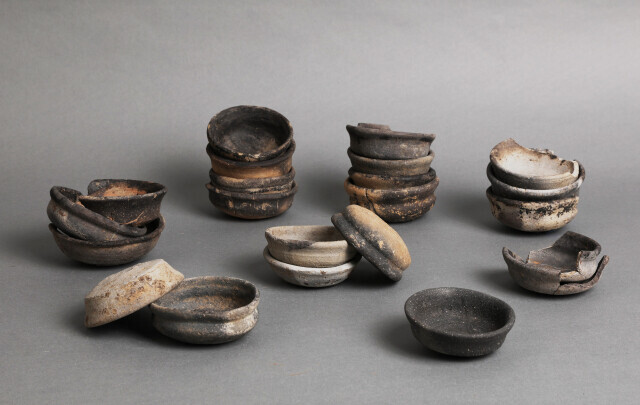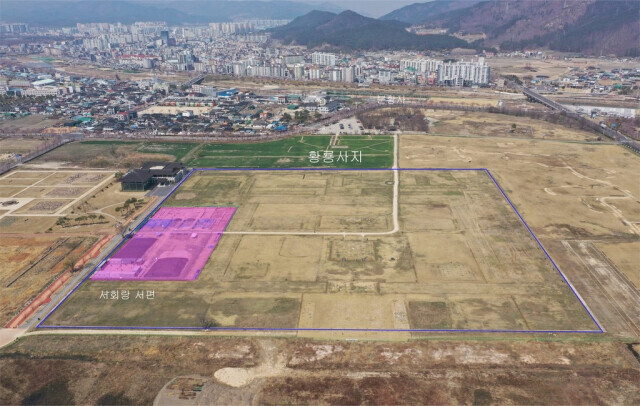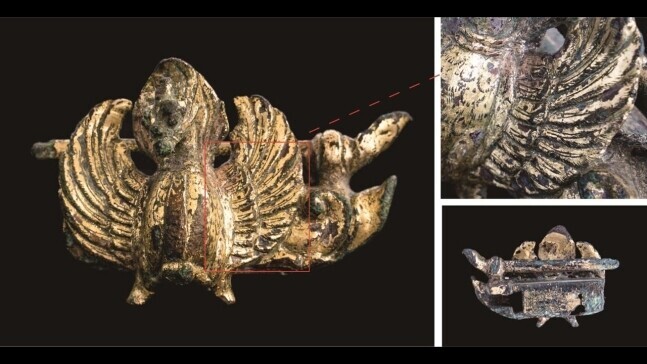hankyoreh
Links to other country sites 다른 나라 사이트 링크
Trove of oil lamps made by Silla craftspeople found near site of Gyeongju temple

A cache of oil lamps from Korea’s Unified Silla period (668–935) has been found at the site of Hwangnyong Temple in Gyeongju, North Gyeongsang Province. The temple was the center of Silla Buddhism, as well as the biggest religious facility on the Korean Peninsula during the ancient and medieval eras.
The Gyeongju National Research Institute of Cultural Heritage announced on Nov. 25 that more than 150 oil lamps made by Silla craftspeople were recently discovered in a pit of disposed artifacts. The find was made in a new survey of the western side of the west corridor (an area covering 8,700 square meters) at the Hwangnyong Temple site in the Guhwang neighborhood of Gyeongju.
According to material released by the research institute, the lamps recovered from the pit are generally 10 centimeters in diameter and have a design that’s presumed to date back to the eighth or ninth century CE, falling during the Unified Silla Dynasty.
Several caches of oil lamps have turned up at ancient temple sites in Korea. A large number of lamps were found during a survey of Hwangnyong Temple in 1976–1983, and more than 80 were unearthed from the site of a Baekje-era temple in Buyeo, South Chungcheong Province.

When archaeologists survey waste pits at ancient building sites, they generally find roof tiles and pottery shards. But the pit found in this survey wasn’t on a building site, and most of the items unearthed were oil lamps. Those are clear indications that the lamps were buried deliberately. An institute spokesperson said researchers will conduct a technical analysis of the soot on the oil lamps to determine why they were buried.
Walls, drains and buildings that were presumably built in the Unified Silla or Goryeo periods also turned up in the area of the dig. Precise measurements showed that the ground in the area gradually slopes from west to east, and there were also fresh indications that a building site from the Unified Silla period had been covered with dirt and used as the foundation for a Goryeo-era building.
Given the state of the building site and unearthed artifacts, archaeologists have speculated that the area around the west corridor was used for operating the temple or as a dormitory for the monks. By surveying the sites and artifacts discovered in this survey, researchers believe, it will be possible to gain a more accurate understanding of the nature of the space and the changes it has undergone.
“In our surveys of ancient temples, our research focused on their primary structures, including the main halls and pagodas, and we hadn’t done enough to research the spaces in temples where monks lived and ran the facilities. The results of this survey should serve as a good basis for determining the overall layout of the halls for Buddhist services and the living quarters at the temple and for learning what life was like in Silla temples and monasteries,” the institute said.

The west corridor area is where the Gyeongju Historical Remains Excavation Research Group (the forerunner of the cultural heritage institute) had its office building when it was conducting a dig at the site in the 1970s and 1980. The area was excluded from the initial survey, but the institute launched an official dig there in 2018. As of last year, a considerable number of building sites and drains had been found, as well as a phoenix-shaped decorative gilt bronze padlock measuring 6 centimeters in length.
Hwangnyong Temple measures at least 100,000 square meters — and that’s only the part that has been discovered so far. Construction on the temple was completed in the sixth century, during the reign of King Jinheung of Silla.
The temple’s glory lasted for seven centuries until it was burned down during an invasion by the Mongol armies in the 13th century. The temple was symbolized by the wooden pagoda that stood around 68 meters tall — far taller than a 20-story building today. That was the biggest and tallest structure on the Korean Peninsula in ancient times.
By Roh Hyung-suk, culture correspondent
Please direct questions or comments to [english@hani.co.kr]

Editorial・opinion
![[Column] Park Geun-hye déjà vu in Yoon Suk-yeol [Column] Park Geun-hye déjà vu in Yoon Suk-yeol](https://flexible.img.hani.co.kr/flexible/normal/500/300/imgdb/original/2024/0424/651713945113788.jpg) [Column] Park Geun-hye déjà vu in Yoon Suk-yeol
[Column] Park Geun-hye déjà vu in Yoon Suk-yeol![[Editorial] New weight of N. Korea’s nuclear threats makes dialogue all the more urgent [Editorial] New weight of N. Korea’s nuclear threats makes dialogue all the more urgent](https://flexible.img.hani.co.kr/flexible/normal/500/300/imgdb/original/2024/0424/7317139454662664.jpg) [Editorial] New weight of N. Korea’s nuclear threats makes dialogue all the more urgent
[Editorial] New weight of N. Korea’s nuclear threats makes dialogue all the more urgent- [Guest essay] The real reason Korea’s new right wants to dub Rhee a founding father
- [Column] ‘Choson’: Is it time we start referring to N. Korea in its own terms?
- [Editorial] Japan’s rewriting of history with Korea has gone too far
- [Column] The president’s questionable capacity for dialogue
- [Column] Are chaebol firms just pizza pies for families to divvy up as they please?
- [Column] Has Korea, too, crossed the Rubicon on China?
- [Correspondent’s column] In Japan’s alliance with US, echoes of its past alliances with UK
- [Editorial] Does Yoon think the Korean public is wrong?
Most viewed articles
- 1[Column] Park Geun-hye déjà vu in Yoon Suk-yeol
- 2N. Korean hackers breached 10 defense contractors in South for months, police say
- 3Thursday to mark start of resignations by senior doctors amid standoff with government
- 4[Editorial] New weight of N. Korea’s nuclear threats makes dialogue all the more urgent
- 5Kim Jong-un expressed ‘satisfaction’ with nuclear counterstrike drill directed at South
- 6Will NewJeans end up collateral damage in internal feud at K-pop juggernaut Hybe?
- 7[Editorial] Japan’s rewriting of history with Korea has gone too far
- 8[Cine feature] A new shift in the Korean film investment and distribution market
- 9[Column] ‘Choson’: Is it time we start referring to N. Korea in its own terms?
- 10[Column] The clock is ticking for Korea’s first lady